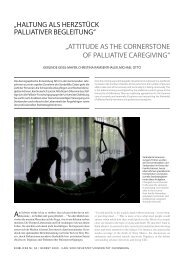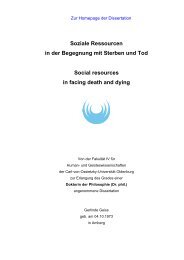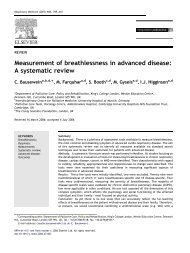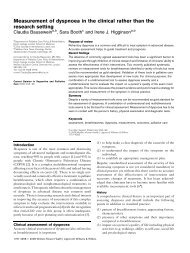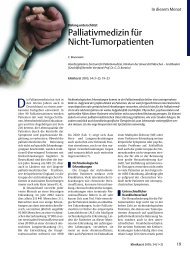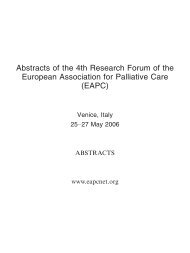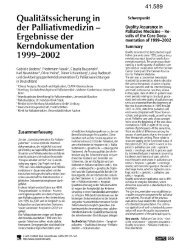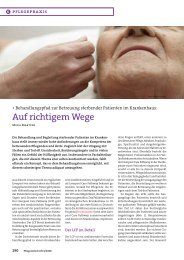EAPC - ipac
EAPC - ipac
EAPC - ipac
Create successful ePaper yourself
Turn your PDF publications into a flip-book with our unique Google optimized e-Paper software.
416 <strong>EAPC</strong> Abstracts<br />
achieve this, several factors that may influence the pain experience and<br />
prognosis as well as the effect of treatment will have to be taken into account.<br />
Firstly, there are factors related to the pain per se, e.g. the occurrence of<br />
breakthrough pain, and the location and mechanisms of pain. Secondly, there<br />
are factors related to the patient, e.g. former use of analgesics and/or other<br />
drugs, the patient’s age and his/her emotional status, and thirdly there are disease<br />
related factors e.g. cancer diagnosis and metastatic pattern. Although the<br />
impact on pain experience, prognosis and treatment of some of these factors<br />
is well described, the influence and importance of others are more poorly<br />
understood. Hence, to decide which factors to include in the classification<br />
system, further exploration and testing is necessary. Within the frames of the<br />
EPCRC, this will be done through multinational patient and expert evaluation,<br />
and by means of an international clinical study. The hypothesis is that<br />
all three categories of factors, i.e pain-, patient-, and disease related, will have<br />
to be included. A first proposal will be presented.<br />
56 Invited Lecture<br />
EPCRC, IASP and WHO: A step forward in Cancer Pain diagnosis<br />
and treatment<br />
Pain assessment – a standardised computer based tool in the<br />
near future<br />
Authors: Marianne Hjermstad Department of Oncology Ulleval University<br />
Hospital NORWAY<br />
repesenting the EPCRC<br />
Background: Many patients experience suboptimal pain control, due to<br />
inadequate pain assessment. The lack of agreement on how to assess and<br />
classify pain demonstrates the need for inter-disciplinary collaboratives like<br />
the EPCRC to reach consensus on pain and symptom assessment in<br />
advanced cancer. Objectives: To develop a consensus based symptom<br />
assessment tool for use in practice and research. Methods: The development<br />
process largely follows the Delphi technique, an iterative multistage<br />
process to reach group consensus, consisting of 9 steps: 1). Constructing an<br />
item pool from literature reviews and expert reviews on pain<br />
dimensions/items, 2). Clinical computerized study testing the item pool,<br />
3). Data analyses/publications, 4). 2nd expert review, 5). Patient interviews,<br />
pilot studies, 6.) Defining items/dimensions and the computerized analysis<br />
model, 7.) 2nd data collection, international, 8). Data analyses/publications,<br />
9). First version of the assessment tool. Results: As of April 2008, we have<br />
completed the first 5 steps with publications in progress. Patients, clinicians<br />
and researchers have contributed at all stages. Three main categories for<br />
classification of pain are identified: pain factors, patient variables, disease<br />
factors. The clinical study yielded 732 pain assessments. Analyses showed<br />
that the included pain interference items generally performed less well than<br />
the pain intensity items, and that numerical rating scales (NRS) may be<br />
superior to verbal rating scales for raring pain intensity. Few patients scored<br />
above 5. Assessment by computers was well accepted by patients. Software<br />
programming for the multicenter study (12 centers) is ongoing. Advanced<br />
programming makes possible comprehensive pain assessment and rapid<br />
pain screening at the same time, for use in different clinical situations.<br />
Conclusion: With all users; patients, clinicians, researchers involved in the<br />
development process, it should be possible to develop a first version of a<br />
consensus based assessment tool.<br />
57 Invited Lecture<br />
EPCRC, IASP and WHO: A step forward in Cancer Pain diagnosis<br />
and treatment<br />
Cancer pain guidelines in the EPCRC project<br />
Authors: Augusto Caraceni National Cancer Institute Rehabilitation and<br />
Pallliative Care Unit ITALY<br />
Stein Kaasa Palliative Medicine Unit Trondheim NORWAY<br />
Geoffrey Hanks Bristol Hematology and Oncology Centre Bristol UNITED<br />
KINGDOM<br />
Jane Gibbins Bristol Hematology and Oncology Centre Bristol UNITED<br />
KINGDOM<br />
Cinzia Brunelli National Cancer Institute Milan ITALY<br />
Alessandra Pigni National Cancer Institute Milan ITALY<br />
repesenting the EPCRC<br />
Background: Aim: In order to revise and update the <strong>EAPC</strong> recommendations<br />
on opioid administration, published in 2001, we conducted a literature<br />
search of available chronic cancer pain guidelines. Methods: This was done<br />
through an internet search from various websites (Google, Pubmed and<br />
Cochrane library). A list of 18 guidelines on pain treatment published after<br />
2000, was found. Seventeen available in English and one in French only; in<br />
particular 9 U.S. guidelines, 7 from European countries, one Asiatic and one<br />
Australian. The content of national and international guidelines were compared<br />
with the 20 <strong>EAPC</strong> recommendations. Not all the 20 recommendations<br />
were considered by each guideline, and in some cases the strenght of recommendations<br />
was completely different from <strong>EAPC</strong>. The structure, the methods<br />
and the content of all guidelines have been reviewed and compared with<br />
<strong>EAPC</strong> guidelines. Results: Most guidelines include additional subjects not<br />
covered by <strong>EAPC</strong> recommendations; e.g. indications about when to use<br />
adjuvant drugs, nonsteroidal anti-inflammatory drugs (NSAIDs), bisphosphonates,<br />
radionuclides and radiotherapy. The comparison of all guidelines<br />
lead to the formulation of 37 key points to be potentially included in the new<br />
<strong>EAPC</strong> guideline. Conclusions: An international expert group of 27 members<br />
has been appointed to participate in the guideline development process.<br />
58 Invited Lecture<br />
EPCRC, IASP and WHO: A step forward in Cancer Pain diagnosis<br />
and treatment<br />
Cancer pain and the WHO analgesic ladder: time for reappraisal<br />
Authors: Geoffrey Hanks Department of Palliative Medicine Bristol<br />
Haematology and Oncology Centre UNITED KINGDOM<br />
The ‘WHO ladder’ has been the guiding concept in the management of cancer<br />
pain worldwide for more than 20 years.This has been one of the most<br />
influential and enduring guidelines in modern clinical practice. How effective<br />
is the WHO method The prospective observational validation studies<br />
demonstrated that roughly 80% of patients achieve good pain control (1).<br />
The validity of this figure has been questioned (2) and there is no evidence<br />
from RCTs to support it. There is evidence that many patients still suffer<br />
unrelieved pain (3,4) and recent data from Bristol suggest that many<br />
patients may suffer troublesome pain in spite of treatment according to current<br />
best practice. The WHO guidelines need to be updated. What will<br />
change The utility of Step 2 has long been questioned and specifically<br />
whether the inclusion of Step 2 delays achievement of optimum pain control<br />
for some patients. Recent data suggest that a two step approach may be<br />
a safe and better alternative to the conventional ladder in these patients but<br />
more robust evidence is required. Various aspects of the use of Step 3 opioids<br />
(drug of first choice, role of active metabolites, opioid-poorly responsive<br />
pain, opioid switching, management of breakthrough pain) continue to<br />
excite debate. These topics will be considered in the updating of the <strong>EAPC</strong><br />
opioid guidelines, part of the EPCRC programme. Cancer pain continues to<br />
be a major public health problem worldwide, affecting many millions of<br />
patients. Several international initiatives have recently been launched<br />
involving the WHO, IASP (International Association for the Study of Pain),<br />
and the EPCRC all of which are aimed at improving our management of<br />
cancer pain. The topic is very much on the scientific and political agendas.<br />
59 Oral Presentation<br />
Education and Epidemiology<br />
Assessing the Effectiveness of International Palliative Care<br />
Education Interventions using Standardized Competence and<br />
Knowledge Evaluations<br />
Authors: Frank Ferris Center for Palliative Studies San Diego Hospice &<br />
Palliative Care U. STATES<br />
Mary Wheeler Capital Hospice Fairfax, VA U. STATES<br />
Kathleen Foley Open Society Institute New York U. STATES



